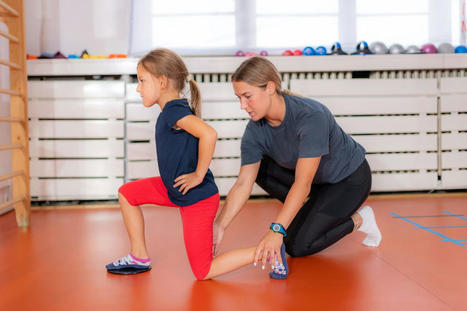The Adams forward bend test is a simple screening method that can help with scoliosis diagnosis and help in developing a treatment plan. The exam is named after the English physician William Adams. As part of an examination, a doctor or chiropractor will look for an abnormal side-to-side bend in the spine.
Scoliosis Diagnosis
- The Adams forward-bend test can help determine if there are indicators for scoliosis.
- It is not an official diagnosis, but the results can be used as a starting point.
- The test is done with school-age children between 10 and 18 to detect adolescent idiopathic scoliosis or AIS.
- A positive test is a noticeable asymmetry in the ribs with a forward bend.
- It can detect scoliosis in any part of the spine, especially in the thoracic middle and upper back.
- The test is not only for kids; scoliosis can develop at any age, so it is also effective for adults.
Adams Forward Bend Test
The test is quick, easy, and painless.
- The examiner will check to see if anything is uneven when standing straight,
- Then the patient will be asked to bend forward.
- The patient is asked to stand with their legs together, facing away from the examiner.
- Then patients bend forward from the waist, with arms hanging vertically downward.
- The examiner uses a scoliometer-like level to detect asymmetries within the spine.
- Deviations are called the Cobb angle.
The Adams test will reveal signs of scoliosis and/or other potential deformities like:
- Uneven shoulders
- Uneven hips
- Lack of symmetry between the vertebrae or the shoulder blades.
- The head does not line up with a rib hump or the pelvis.
Detection of Other Spinal Issues
The test can also be used to find spinal curvature issues and conditions like:
- Kyphosis or hunchback, where the upper back is bent forward.
- Scheuermann's disease is a form of kyphosis where the thoracic vertebrae can grow unevenly during a growth spurt and cause the vertebrae to develop into a wedge-like shape.
- Congenital spine conditions that cause an abnormal curve of the spine.
Confirmation
The Adams test by itself is not enough to confirm scoliosis.
- A standing X-ray with Cobb angle measurements above 10 degrees is required for diagnosing scoliosis.
- The Cobb angle determines which vertebrae are tilted the most.
- The higher the angle, the more severe the condition and the more probable it will produce symptoms.
- Computed tomography or CT and magnetic resonance imaging or MRI scans can also be used.
Forward Bend Test
The information herein is not intended to replace a one-on-one relationship with a qualified healthcare professional or licensed physician and is not medical advice. We encourage you to make your own healthcare decisions based on your research and partnership with a qualified healthcare professional. Our information scope is limited to chiropractic, musculoskeletal, physical medicines, wellness, sensitive health issues, functional medicine articles, topics, and discussions. We provide and present clinical collaboration with specialists from a wide array of disciplines. Each specialist is governed by their professional scope of practice and their jurisdiction of licensure. We use functional health & wellness protocols to treat and support care for the injuries or disorders of the musculoskeletal system. Our videos, posts, topics, subjects, and insights cover clinical matters, issues, and topics that relate to and directly or indirectly support our clinical scope of practice.* Our office has reasonably attempted to provide supportive citations and identified the relevant research study or studies supporting our posts. We provide copies of supporting research studies available to regulatory boards and the public upon request.
We understand that we cover matters that require an additional explanation of how it may assist in a particular care plan or treatment protocol; therefore, to further discuss the subject matter above, please feel free to ask Dr. Alex Jimenez or contact us at 915-850-0900.
Dr. Alex Jimenez DC, MSACP, CCST, IFMCP*, CIFM*, ATN*
email: coach@elpasofunctionalmedicine.com
Licensed in: Texas & New Mexico*
References
Glavaš, Josipa et al. "The role of school medicine in the early detection and management of adolescent idiopathic scoliosis." Wiener klinische Wochenschrift, 1–9. 4 Oct. 2022, doi:10.1007/s00508-022-02092-1
Grossman, T W et al. "An evaluation of the Adams forward bend test and the scoliometer in a scoliosis school screening setting." Journal of pediatric orthopedics vol. 15,4 (1995): 535-8. doi:10.1097/01241398-199507000-00025
Letts, M et al. "Computerized ultrasonic digitization in the measurement of spinal curvature." Spine vol. 13,10 (1988): 1106-10. doi:10.1097/00007632-198810000-00009
Senkoylu, Alpaslan, et al. "A simple method for assessing rotational flexibility in adolescent idiopathic scoliosis: modified Adam's forward bending test." Spine deformity vol. 9,2 (2021): 333-339. doi:10.1007/s43390-020-00221-2



 Your new post is loading...
Your new post is loading...









The Adams forward bend test is a simple screening method that can help with scoliosis diagnosis and help in developing a treatment plan. For answers to any questions you may have, please call Dr. Jimenez at 915-850-0900 or 915-412-6677